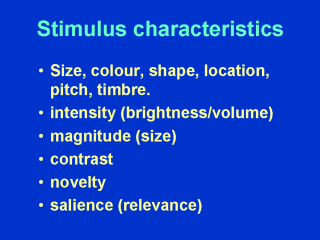| front |1 |2 |3 |4 |5 |6 |7 |8 |9 |10 |11 |12 |13 |14 |15 |16 |review |
 |
These stimulus characteristics
include colour, shape, size, location, pitch, timbre, and so forth. These correspond to
the physical features of objects or voices (for example). Their intensity can be
considered a separate dimension, from almost undetectable through to damagingly intense, a
dimension corresponding to the stimulus energy content. Magnitude is also important. The size dimension helps us make informed judgements about the probable nature of stimuli. Size is obviously related to spatial location, and this has an important bearing on our ability to negotiate our physical environment. Contrast phenomena are noticeable, mostly in terms of vision, where colour contrast provides a more “visible” presentation than might otherwise be the case. Animals use contrast to signal warnings and advertisers use it to attract you attention. These examples illustrate the attention-grabbing nature of contrasts. Novelty, “newness”, is a powerful means of attracting attention. Our tendency to be drawn towards novel things, curiosity, is important in helping us learn more about the environment, being better able to achieve evolutionary goals as we do so; survival and access to food, safety and opportunities for reproduction. Salience means “relevance”. Salience directs our attention to look out for certain stimuli associated with our current needs, such as food, reproduction, shelter, and so forth. When a need is met, stimuli associated with that no longer command our attention and may be ignored. |